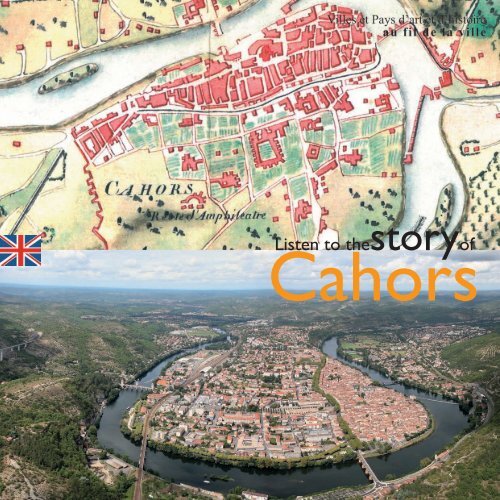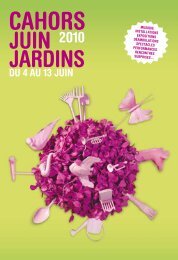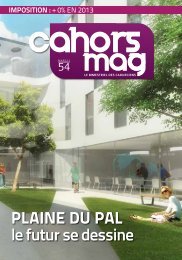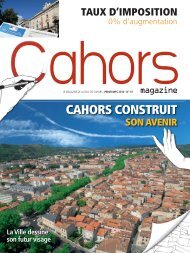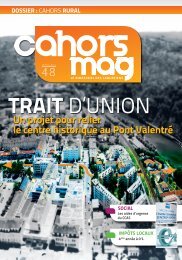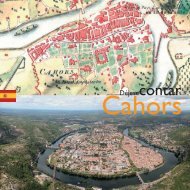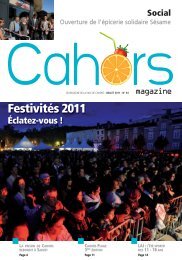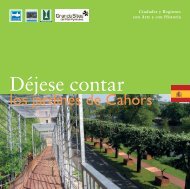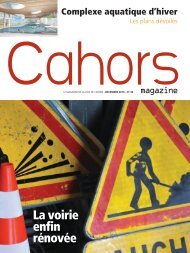Create successful ePaper yourself
Turn your PDF publications into a flip-book with our unique Google optimized e-Paper software.
<strong>Listen</strong> <strong>to</strong> thes<strong>to</strong>ryof<strong>Cahors</strong>
The Fontaine des Chartreux resurgent river, the origin of <strong>Cahors</strong>,flows in<strong>to</strong> the Lot <strong>to</strong> the south west of the meander.Drawn up in 1638 by Chris<strong>to</strong>phe Tassin, Geographer <strong>to</strong> the King, this map shows the bipartite layout of the citybefore the 19th C.A city takes shapeFounded by the Romans within a vast meander of the Lot surrounded by steep hillslopes,the antique city of <strong>Cahors</strong> occupied the whole of the loop, but in the MiddleAges retreated <strong>to</strong> just the eastern third. After the Revolution, the city expanded <strong>to</strong> occupythe entire meander once more. In the 20th C, it extended northwards and also<strong>to</strong>ok over the alluvial land on the left bank.An antique city within ameanderThe meander of the Lot, surroundedon three sides by steep hills, isthe site of a prolific Vauclusianspring, which was a place of worshipfor the Cadurci, the nativeGauls. Initially, this Celtic peoplelived in hill-forts, such as those atMurcens or Luzech.At some time <strong>to</strong>wards the beginningof the 1st century of our era,the Romans founded the city of Divonawithin the meander, unoccupieduntil then. Besides the protectionafforded by the river, the sitewas the meeting point of three importantroutes which led <strong>to</strong> Bordeaux(Burdigala), Rodez (Segodunum)and Toulouse (Tolosa). Theantique city grew <strong>to</strong> occupy virtuallythe whole of the meander.<strong>Cahors</strong>, a city of two parts inthe early Middle AgesAfter the fall of the Roman Empire,the city retreated <strong>to</strong> the easternthird of the meander. In the 7th C.,the bishop St. Didier built or rebuiltthe walls and added a ditch, whichlay where the boulevard Gambettanow runs.A city of trade and commerce, thecapital of a small county whoseoverlord was the Bishop, <strong>Cahors</strong>developed considerably between the12th and 14th C.: the city properwas confined <strong>to</strong> the east of theditch, protected by the St. Didierwall. Here, the narrow streets ledoff the Grande Rue, the main commercialaxis running from north <strong>to</strong>south of the city. To the west of theditch, religious orders founded largeestablishments, surrounded bymany gardens. This two-part structureis still clearly visible <strong>to</strong>day fromthe Mont St. Cyr viewpoint.However, in the 13th C., urbanpressure on land resulted in the appearanceof "barris"; small developmentsoutside the gates in thecity walls. "Barris" also grew upon the other side of the river, thanks<strong>to</strong> the two s<strong>to</strong>ne bridges: in the east,around the Dominican monasteryon the Cabessut plain, where therewere market gardens, and <strong>to</strong> thesouth, the St. Georges suburb alongthe Toulouse road. In the 14th C.,the Consuls' intention <strong>to</strong> create anew quarter in the west of themeander led <strong>to</strong> the building of theValentré Bridge, emblem of the city.The Hundred Years' War necessitatedthe construction of a second lineof fortifications cutting the meanderoff from the north.In 1219, the river traffic on the Lotwas the subject of an agreementbetween the Consuls and the Bishop<strong>to</strong> create a navigation channelfrom <strong>Cahors</strong> <strong>to</strong> Fumel, with weirsat intervals <strong>to</strong> retain water. Thesedevelopments were modernised duringthe reign of Louis XIV, atwhich time the first locks werebuilt.Despite the construction of somelarge buildings in the 17th C., suchas the Bishops' Palace, the church ofthe Regular Canons and the JesuitCollege, the urban structure of <strong>Cahors</strong>remained the same until the19th C.
In the 19th C., the Boulevard Gambetta became the mainthoroughfare of <strong>Cahors</strong>.The city's contemporary urban development is concentratedlargely <strong>to</strong> the north of the meander and on the left bankof the Lot.<strong>Cahors</strong> is surrounded by a limes<strong>to</strong>ne plateau ("causse")dotted with fine rural buildings.The 19th C. : opening up the old<strong>to</strong>wn, re-occupation of the wes<strong>to</strong>f the meanderAfter the Revolution, the consequentclosure of religious foundationsand the sale of their buildingsas "National Property", <strong>Cahors</strong> expandedwestwards in the 19th C.,replacing the former monasteriesand convents with institutional, industrialor cultural buildings, suchas the Law Courts, the <strong>to</strong>baccodrying/packing plant and the library.The Boulevard Gambetta, built overthe filled-in ditch, became the city'smain thoroughfare in the 19th C.,lined with cafés, banks and administrativebuildings. Two largesquares opened on <strong>to</strong> it: in thesouth, the Place d'Armes prolongedby a promenade, the Cours Fénelon(now the Allées Fénelon); in thenorth, the Place Thiers (now Placede Gaulle) originally intended as amilitary exercise ground. To thesouth, the Louis Philippe bridge,opened in 1838, carried the roadover the Lot.New east-west streets or realignmentsof old ones opened the mediaeval<strong>to</strong>wn up <strong>to</strong> the boulevard <strong>to</strong>some extent: e.g. Rue Foch (1822),Rue Feydel (1834) or Rue Brives(1836).The modernisation of the city, nowa Préfecture (roughly equivalent <strong>to</strong>a county <strong>to</strong>wn), included theconstruction of the "quais" (roadsrunning beside the river) and theinstitution of a public hygiene policy,which <strong>to</strong>ok concrete form in1854 with the construction of theCabazat pumping station, enablingclean drinking water from the Fontainedes Chartreux <strong>to</strong> be pipedaround the city.From 1869 onwards, the railwaysbegan <strong>to</strong> establish themselves on thewestern fringe of the meander.The 20th C.: living in the citywhilst preserving its heritageTopographical constraints, the virtualabsence of industry and later,the legislation regarding His<strong>to</strong>ricMonuments, have engendered urbandevelopment which is respectfulof the old. It is mainly concentratedin the north of the meander(Saint-Namphaise, Sainte-Valérie,Lamothe, Bellevue and Regourd)and the flat areas on the left bank ofthe Lot: Cabessut and Terre Rougein the east, Saint-Georges in thesouth, Croix-de-Fer in the west.Beyond these quarters, commercialand industrial zones extend alongthe Toulouse road <strong>to</strong> the south, <strong>to</strong>the west on the Labéraudie plainand in Regourd <strong>to</strong> the north.<strong>Cahors</strong>, with its 20,000 inhabitants,includes within its boundaries a significantrural area, composed of alimes<strong>to</strong>ne plateau dotted with numeroushamlets, around whichthere is increasing pressure on buildingland.
This idealised 20th C. bust represents Lucterius,the last Gaulish chief <strong>to</strong> have resistedCaesar.This dolphin mosaic is one of the 50 antiquemosaics found in <strong>Cahors</strong>.The Te Igitur, on which oaths were sworn, is amediaeval <strong>to</strong>wn council register, in which thecity cus<strong>to</strong>ms are set down.Windows 117, Rue de Lastié, 14th C.The city through the agesThe capital of the Cadurci, Romanised Gauls, became a rich merchant city in theMiddle Ages, and then in the 16th - 18th C. an intellectual and administrative centre,little <strong>to</strong>uched by the Reformation. "County <strong>to</strong>wn" of a rural "département"since the Revolution, surrounded by ancient vineyards, commerce and administrationare the essence of <strong>Cahors</strong>' activity.Divona, capital of theRomanised Cadurci peopleThe Cadurci, who gave their name <strong>to</strong>Quercy, were the last people <strong>to</strong> offerarmed resistance <strong>to</strong> Caesar under thecommand of a former lieutenant ofVercinge<strong>to</strong>rix, Lucterius, who escapedfrom Alesia. The final capitulationcame after the battle of Uxellodunumin 51 B.C., which put an end<strong>to</strong> the Gallic Wars.Founded in the centre of the Cadurci'sterri<strong>to</strong>ry during the reign of Augustus,the sanctuary-city grew up close <strong>to</strong> aresurgent river sacred <strong>to</strong> the Celticgoddess Divona, whose name it adopted.Although we know nothing ofthe city's exact status or configuration,archaeology constantly revealsits opulence: a theatre, an amphitheatre,a monumental baths complex, acircular temple…These s<strong>to</strong>od on a regular,rectilinear street layout, and onecan imagine the streets lined withcraftsmen's shops and fine houses decoratedwith mosaics. The discoveryof several potters' kilns, plus the mentionby Strabo, Pliny the Elder and Juvenalof a high-quality locally-producedlinen cloth are indicative of athriving craft industry.Saint Didier, Bishop and builderDestroyed during various invasions,<strong>Cahors</strong> retreated <strong>to</strong> the eastern thirdof the meander. From 630 <strong>to</strong> 655, theprovince of Quercy was governed byBishop Didier, a member of the aris<strong>to</strong>cracyof Aquitaine and former treasurer<strong>to</strong> King Dagobert: in <strong>Cahors</strong>, hereinforced the fortifications, hadmuch work done on the cathedraland founded the monastery of St.Géry. We know very little about thecity in the early Middle Ages exceptduring this bishop's reign.<strong>Cahors</strong>, a mediaeval centre oftrade and commerceThe 12th <strong>to</strong> 14th C. was a GoldenAge for the capital of Quercy. Influencedby bankers from Lombardy,who had come <strong>to</strong> <strong>Cahors</strong> in the wakeof the Albigensian Crusade, a few leadinglocal families, such as the DeJean, Béral, De Via or Duèze, <strong>to</strong>ok upbanking and international commerce.The streets of the city were alive andbustling with commercial and craftactivity.In the 13th C., the Bishop's powerwas increasingly challenged by theConsulate, a civic assembly made upin the 14th C. of 12 notables, six representingthe city's quarters and sixthe trade guilds: they regulated thepublic domain, owning hospitals,markets and butchers' shops. The religiouspresence was still very strong,with the cathedral complex, the fourMendicant Orders (Dominicans,Franciscans, Augustinians and Carmelites),the Carthusians and ten parishchurches, not <strong>to</strong> mention facilitiesfor pilgrims <strong>to</strong> Santiago de Compostelafollowing the Puy en Velay route.To settle the differences between Bishopand Consuls, an agreement (paréage)was signed in 1307 dividingthe overlordship equally between theBishop and the King of France: this effectivelyconcretised the Bishop's lossof influence in favour of the Consuls,who, in 1308, laid the first s<strong>to</strong>ne ofthe Valentré Bridge.Born in<strong>to</strong> a rich local bourgeois family,Jacques Duèze became Pope in1316 under the name of John XXII:he founded <strong>Cahors</strong> University in1332. He drew members of the localélite <strong>to</strong> his court in Avignon, and launchedthe reconstruction of the churchof St. Barthélémy. Despite the late instigationof two annual eight-day fairsin 1339, the city's prosperity began <strong>to</strong>
Detail of the entrance <strong>to</strong> the Hôtel d'Alamand,circa 1500.The monument-fountain in honour of ClémentMarot was put up in 1892, thanks <strong>to</strong> the Sociétédes Études du Lot.Work published in <strong>Cahors</strong> by the printer Dalvy in1619.Born in <strong>Cahors</strong>, Léon Gambetta was afamous 19th C. republican parliamentaryfigure.decline, accelerated by the plague in1348 and the Hundred Years' War: in1360, the Treaty of Bretigny cededQuercy <strong>to</strong> the English, but the Cadurciensvery soon rebelled againsttheir domination.11 From the Middle Ages <strong>to</strong> theRenaissanceIn the aftermath of the HundredYears' War, <strong>Cahors</strong>' population wasgreatly depleted. Fifty years after theend of the conflict, a religious and artisticrevival <strong>to</strong>ok place, inspired byBishop An<strong>to</strong>ine d'Alamand: the LadyChapel of the Cathedral (now the"Chapelle Profonde") provides thefirst example of a new, creative style ofsculpture, featuring pruned branchesand full-blown roses, which graduallyspread <strong>to</strong> the city's fine houses.Even though the Renaissance only lefttwo characteristic examples of architecturehere, it was nevertheless animportant period for the city: birthplaceof the humanist poets ClémentMarot and Olivier de Magny, <strong>Cahors</strong>had a vibrant intellectual life. Religiousorders and university collegesprovided scope for printers and booksellerssuch as the Rousseau family.Amongst the University's teacherswere the erudite legal expert Cujasand the theologian Pierre Charron.Despite Galiot de Genouillac, GrandMaster of Artillery under François I,becoming the Seneschal of Quercy in1517, the architecture of <strong>Cahors</strong> waslittle marked by the Italianate stylewhich he favoured. The Reformationmade few converts here, but <strong>Cahors</strong>was the scene of fierce fighting whenHenri de Navarre (the Huguenot leader)<strong>to</strong>ok the city in May 1580.The 17th C.: Counter-Reformation,legal and administrative reorganisationThe most influential person of thisperiod in <strong>Cahors</strong> was Alain de Solminihac(1636-59). A friend of St. Vincentde Paul, he brought the CounterReformation <strong>to</strong> Quercy, founded oneof the first great seminaries in France,and executed his pas<strong>to</strong>ral and charitableduties with indefatigable zeal.Under the aegis of the Jesuits and theUniversity, throughout the first half ofthe century the city remained an activecentre of intellectual life, attractingstudents such as François de Salignacde la Mothe-Fénelon, who became aDoc<strong>to</strong>r of Theology at the University(and later, tu<strong>to</strong>r <strong>to</strong> Louis XIV's grandsons).In 1635, Quercy became part of theMontauban administrative area, andthe chief <strong>to</strong>wn of a tax district. Thepresence of various financial and legalinstitutions attracted a large numberof magistrates, officers and personnelwho occupied the city's fine mediaevalhouses, refurbishing them in the Baroquetaste of the period.The transfer of an important financialtribunal <strong>to</strong> Montauban in 1662, andthe suppression of the University in1751 marked the loss of <strong>Cahors</strong>' formerinfluence in the legal and intellectualdomains."Préfecture" of a rural départementThe "département" of the Lot wascreated in 1790, and <strong>Cahors</strong> becamethe "préfecture" (county <strong>to</strong>wn) in1800. The Lot at this time covered theformer province of Quercy.In the 19th C., <strong>Cahors</strong> was a largelyadministrative and commercial city,little affected by the Industrial Revolution.Modern developments, suchas the Louis Philippe bridge, ceremoniallyopened on 6th May 1838,brought new life <strong>to</strong> the <strong>to</strong>wn. Thehome <strong>to</strong>wn of Gambetta (a very famouspolitician) sent 3 600 soldiers <strong>to</strong>the Franco-Prussian war in 1870. Thephylloxera outbreak in 1876 destroyedthe vineyards, driving manypeople <strong>to</strong> leave the countryside, tendencyreinforced by the two WorldWars, with their contribution of deathand repression. In the 20th C., <strong>Cahors</strong>'population was enriched by thearrival of Spanish Republicans andPortuguese migrant workers.The res<strong>to</strong>ration of the ConservationSec<strong>to</strong>r and the new focus on the Malbecgrape (main variety used for <strong>Cahors</strong>wine) are now strategic vec<strong>to</strong>rs inthe city's development.
The Black Wine of <strong>Cahors</strong> has enjoyed a good reputationsince the Middle AgesThe "Quercynois platter" offers foie gras, walnuts, cured duckbreast and cabécou.In Quercy, the saffron crocus produces a high-quality spiceThe best of local flavour and know-howRenowned since the 13th C. for the distinctive character of its wine, the mere mentionof the name <strong>Cahors</strong> is enough <strong>to</strong> conjure up visions of a quality lifestyle, goodfood and wine, and beautiful, unspoiled surroundings.<strong>Cahors</strong> wineMade principally from the Malbecgrape, as early as the 13th C. <strong>Cahors</strong>wine was particularly enjoyedby the English, who dubbed it"Black Wine". Very tannic, high inalcohol, it survived being transportedlong distances: loaded on <strong>to</strong> flatbot<strong>to</strong>medboats going down theLot, it was the perfect export productin the Middle Ages, and still is.About 1310, the <strong>Cahors</strong> wine tradewas based on a high volume of production,exported in part via theport of Bordeaux. In the 16th C.,King François I (contemporary ofHenry VIII) greatly enjoyed it andhad <strong>Cahors</strong> vines planted in Fontainebleau.<strong>Cahors</strong> wine scaled the heights inthe 18th C.: appreciated in the greatroyal courts of Europe, it becamethe mass wine of the Russian OrthodoxChurch. After 1850, thevines covered 40 000 hectares, andit conquered the national marketthanks <strong>to</strong> the Lot waterway improvementsand <strong>to</strong> the railways.Ravaged by phylloxera from 1876onwards, the vineyards did not recoveruntil after the Second WorldWar, finally obtaining AOC statusin 1971. The AOC <strong>Cahors</strong> areanow covers 4000 hectares, made upof small and medium-sized propertieswhose wines express all thenuances of the appellation.Cabecou cheeseThis creamy little goat's cheesemade from raw milk existed as farback as the 15th C., at which time,so it is said, it was used <strong>to</strong> pay farmrents and taxes. It obtained AOCstatus in 1995 under the appellationRocamadour. This local delicacygoes very well with salad, walnut,smoked duck breast and foie gras <strong>to</strong>make a "Quercynois platter", andcan also be enjoyed with honey.SaffronGrown in Mesopotamia over 4500years ago, the mauve Crocus Sativusspread around the Mediterranean.The bright orange stigmata of its pistilproduce saffron, used as both amedicinal and a dye plant. However,it has always been most appreciatedas a spice. In the Middle Ages,Quercy and the Albi area grew highqualitysaffron, providing half of allthe kingdom's production; and forthis reason, King Henri III granted in1589 the establishment of four annualfairs and a weekly market in Albasin Quercy. Needing meticulouscare and much manual work, thiscrop suddenly disappeared in the18th C.As of 1997, saffron-growing hasbeen revived locally, and the qualityof the spice has obtained officialrecognition.The "black diamond"Known <strong>to</strong> the Romans, forgottenfor most of the Middle Ages, thetruffle is a delicacy which made itsreappearance in the 14th C. on thetable of the Duc de Berry, brother ofKing Charles V. From then on,many references <strong>to</strong> it ex<strong>to</strong>l its flavouras much as its reputed aphrodisiacproperties. The black truffle(tuber melanosporum), called "thePérigord truffle", is found boththere and here in Quercy. Borne onthe rootlets of small oak trees onthe thin, s<strong>to</strong>ny soil of the limes<strong>to</strong>neplateau, on which it can produceburnt-looking patches, this truffle isconsidered by specialists <strong>to</strong> have the
The black truffle is a prized delicacyEvery Wednesday and Saturday morning, a livelymarket is held on the Place ChapouThe windows of the former printers Coueslant,rue Wilson, are decorated with putti surroundedby objects linked with printing.The Secret Gardens have been awarded"Remarkable Gardens" status.best scent and flavour of any kind.It is harvested from December <strong>to</strong>March with the aid of a pig, a dogor by observing the flight of a specificfly. The "black diamond", despiteits increasing rarity, drawscrowds <strong>to</strong> the market in Lalbenqueand graces the cuisine of our bestcreative chefs.Markets and local specialitiesEvery Wednesday and Saturdaymorning, <strong>Cahors</strong> market brings a livelymix of bright colours and deliciousscents <strong>to</strong> the Place Chapou.All the products already mentionedcan be found there, plus numerousother specialities such as Croustilotbread, made with wheat grown inthe Lot, Quercy melons, juicy andsweet, fruit and vegetables grownlocally, Quercy Farm Lamb, producedfrom the Caussenarde breed,and pastis, a cake made with paperthinfilo pastry filled with apple puréeflavoured with alcohol. In addition<strong>to</strong> the outdoor market,throughout the week a coveredmarket and several shops sell localproduce which you can also enjoyin the city's restaurants.Printing and bookbindingThe presence of the University, themunicipal authority and the Bishopencouraged printers <strong>to</strong> set up businessin <strong>Cahors</strong> from the late 16th C.onwards. These businesses involvedentire families, covering both theprinting trade and bookselling. Thefirst dynasty of printers from <strong>Cahors</strong>was founded in 1586 byJacques Rousseau, an itinerantcraftsman from Angers. From the17th C. <strong>to</strong> the 19th C., there werealso the Dalvy, Bonnet and Richardfamilies.In the 17th C., whilst Montaubanproduced Protestant writings by thecartload, <strong>Cahors</strong> was "the mirror ofthe Counter Reformation": the majorityof the 432 publicationsbrought out were in fact religious literaturein some form. Paradoxically,unlike the clergy or the colleges,the University of <strong>Cahors</strong>never used or supported the printersof the city. In the 18th C., activity inthis sec<strong>to</strong>r slowed down, but revivedagain in the late 19th C. underthe aegis of the Coueslant family.This local printing tradition is stillmaintained, in particular by theFrance-Quercy printing company.Craftsmen-bookbinders, booksellers,printers and a renowned AntiqueBook Fair help <strong>to</strong> keep thissec<strong>to</strong>r active.The Secret Gardens and thequality of the environmentThe city created the Secret Gardensin 2002 <strong>to</strong> bring life back <strong>to</strong> abandonedspaces within the old <strong>to</strong>wn.25 in all, they are imaginatively basedon the theme of the mediaevalgarden. Set amongst ancient buildings,each one different, the SecretGardens as a whole have beenawarded "Remarkable Garden"status by the Ministry of Culture.Little affected by industrial development,<strong>Cahors</strong> has retained numerousgreen spaces, both publicand private, within its meander.When you look beyond the river,there is no visual pollution, just aview of the unspoiled landscape ofthe Causse.The "Fontaine des Chartreux" provides<strong>Cahors</strong> with all its drinkingwater, which has a good balance ofminerals and a very low nitrate andpesticide content. Waste water istreated in an innovative sewageplant which employs a biologicalmethod of eliminating pollutionusing specially activated sludge.
The Arc de Diane is a vestige of the Romanbaths of <strong>Cahors</strong>.This large section of the wall of an amphitheatrewas revealed during the construction of an undergroundcar park.The Cathedral of St. Etienne has two Romanesquecupolas.The frieze depicting Genesis dates from1270-1300.All around the <strong>to</strong>wnFrom the Arc de Diane <strong>to</strong> mediaeval houses, from the Valentré Bridge <strong>to</strong> the Cathedral,from the Jesuit College <strong>to</strong> early social housing, two thousand years of his<strong>to</strong>ryhave left their mark for visi<strong>to</strong>rs <strong>to</strong> see.1 18 Traces of antique DivonaAs there are no references or archivedocuments concerning <strong>Cahors</strong>in antique times, ourknowledge of Divona's monumentsdepends on archaeology.The city's origin lies in the resurgentriver of Divona, Celtic goddessof subterranean waters. Theworship of Divona at this Vauclusianspring, now called the Fontainedes Chartreux, intensifiedafter the Romans founded the city,as witness the thousand Gallo-Roman coins found deep in thespring. The most impressive antiquevestige in terms of height is alarge masonry arch erroneouslycalled the "Arc de Diane" : it is infact part of the interior of the frigidarium,containing the cold poolof the Roman baths. Water wasbrought 33km by aqueduct fromsprings in the Vers valley, northeas<strong>to</strong>f <strong>Cahors</strong>, and the bathscomplex covered an area of3000m2. Unlike the foundationsof a large circular temple discoverednear the hospital and coveredup again, the long stretch of amphitheatrewall uncovered duringthe Allées Fénelon archaeologicalexcavations is still visible. Thiswall, faced with small blocks ofdressed limes<strong>to</strong>ne with a solid rubbleinterior, must have run forover 100m east-west. A small vestigeof the Roman theatre is alsovisible beneath the Chamber ofAgriculture building opposite thestation. Fifty mosaics and objectssuch as a sarcophagus decoratedwith a hunting scene (conserved inthe <strong>Cahors</strong> Henri-Martin Museum)have also been excavatedfrom antique Divona.13 The cathedral complexTraditionally, the building of theearly Cathedral of St. Etienne andits ecclesiastical complex has beenattributed <strong>to</strong> the bishop St. Didierin the 7th C. Pope Calixtus IIconsecrated the Romanesque cathedral'stwo main altars in 1119.The nave, covered by two of thelargest cupolas in the South-West,gave on <strong>to</strong> an ambula<strong>to</strong>ry with radiatingchapels. The tympanum ofthe north doorway, dating fromthe middle of the 12th C., showsthe Ascension of Christ and themartyrdom of St. Stephen(Etienne). In the 13th and 14th C.the Gothic style left its mark onthe east end, the massive western<strong>to</strong>wer and the chapel of St. Martin;and the cloister, along with thechapel of St. Gausbert, was rebuiltin the Flamboyant Gothic style,starting in 1493. Some importantvestiges of mediaeval wall paintinghave been conserved, such asthose in the western cupola andthe frieze depicting Genesis in thewestern <strong>to</strong>wer. There are severalremarkable elements dating fromthe 17th and 18th C. such as thereredos of the Chapelle Profonde(late 17th C.) and the Canons'Gallery (1734). The apse wascompletely repainted in the 19thC. by Cyprien-An<strong>to</strong>ine Calmon,an artist from <strong>Cahors</strong>, at the sametime as the stained-glass windowswere installed.10 12 15 <strong>Cahors</strong>, a conserva<strong>to</strong>ryof mediaeval housesThe wealth and variety of mediaevalbuildings in <strong>Cahors</strong> isconstantly being revealed as res<strong>to</strong>rationwork is undertaken in the 30hectares of the Conservation Sec<strong>to</strong>r.
N° 12 rue de la Daurade is one of the oldesthalf-timbered houses in the South of France.The pulpit of the church of St. Barthélémy is a fineexample of 17th C. church furniture.A statue of the Virgin and Child decorates the façadeof the church of St. Urcisse.The Valentré Bridge is the monumentwhich symbolises <strong>Cahors</strong>.Several hundred houses from the12th - 14th C., with widely varyingstyles and features, are still standing;from 13th C. half-timberedhouses such as that at n° 12, rueDaurade <strong>to</strong> the Chantrerie, a merchants'lodge of the 14th C.; frombourgeois houses with shop arcadesin the rue du Château du Roi <strong>to</strong> theDuèze and de Via urban palaces.The pragmatism, creativity andpower of the people of mediaeval<strong>Cahors</strong> are manifest in this host ofbuildings.These houses, composed of fourmain building materials : <strong>Cahors</strong> limes<strong>to</strong>ne,Figeac sands<strong>to</strong>ne, brickand wood, often still have visibleshop arcades on the ground floorand finely-sculpted windows on theupper floors. The rues Nationale,de la Chantrerie, de la Daurade, duChâteau du Roi and des Soubirousprovide a representative sample ofthe mediaeval houses of <strong>Cahors</strong>.16 St. Barthélémy ChurchFormerly St. Etienne des Soubirous,St. Barthélémy is one of the ten parishchurches within <strong>Cahors</strong> in theMiddle Ages. This big building inthe Southern Gothic style is flankedby a large bell-<strong>to</strong>wer-cumporchwith pointed-arch openingson three levels. Jacques Duèze wasbaptised there in 1244. After beingelected Pope, he ordered its reconstruction.Close by, his brother Pierrehad the imposing palace with itstall corner <strong>to</strong>wer built. In 1644, St.Barthélémy was attached <strong>to</strong> theGreat Seminary founded by the bishopAlain de Solminihac. Thechurch contains mediaeval wallpaintings, an interesting collectionof paintings dating from the 17th C.<strong>to</strong> the 20th C. and a wooden pulpitdating from 1663 made by the mastercraftsman carpenter BertrandRouzières of <strong>Cahors</strong>.6 St. Urcisse ChurchIn the Badernes quarter, this parishchurch founded in early times is namedfor a 6th C. bishop of <strong>Cahors</strong>.The present structure is the result ofseveral building campaigns datingfrom the 12th - 19th C. The centralnave is flanked by two side-aisles. Itis just possible <strong>to</strong> identify the presenceof the Romanesque portal decoratedwith billets on the southwall; it was no doubt abandoned inthe early 14th C. in favour of thelarge portal with arched mouldingsopened in the west front. This doorwaywith niches for statues at theside and rather summary foliate decorationframes a partially re-workedmediaeval statue of the Virginand Child.19 20 The Valentré bridge andsurroundingsIn the 14th C., three bridges spannedthe Lot in <strong>Cahors</strong>: the OldBridge, in the south, dating nodoubt from the12th C. (possibly onantique foundations) followed onfrom the mediaeval main street; the13th C. New Bridge in the east led<strong>to</strong> the Dominican monastery andthe Villefranche road; and the ValentréBridge in the west, the onlyone <strong>to</strong> survive, intended <strong>to</strong> serve anew quarter of the city. This iconicstructure was decided on by theConsuls in 1306, and work on itcontinued until about 1380. A listedHis<strong>to</strong>ric Monument since 1840, itwas res<strong>to</strong>red in a respectful mannerby the architect Paul Gout in the19th C.: he reinforced its militaryaspect, and had a small devil-figurecarved at the <strong>to</strong>p of the central <strong>to</strong>weras a reminder of the legend claimingthat Satan had a hand in thebuilding. It has three <strong>to</strong>wers, two ofwhich are fortified, and the slightlyhumped roadway is carried on wideGothic arches. It is the best preserved,most representative mediaevalfortified bridge in France.Upstream lies the Fontaine desChartreux, a resurgent river sacred<strong>to</strong> the Gauls and now the source ofall <strong>Cahors</strong>' drinking water. Featureslinked <strong>to</strong> river transport are still visible:the <strong>to</strong>wpath, weir and lock.The latter has walls with roundedends, indicating their 19th C. origin.Fifty metres upstream from thebridge, the former pumping stationfor the waters of the Fontaine desChartreux, Cabazat, has becomethe "Maison de l'Eau", where exhibitionsand activities on the themeof water and the Valentré Bridgeare held.
The "Maison de l'Eau" occupies the formerCabazat water pumping station.The St. Michel Gate formerly opened on <strong>to</strong> theBordeaux road.The "Chapelle Profonde" in the cathedral has arichly-carved décor.The façade of the Archdeacon's House is anexample of the first French Renaissance style.All around the <strong>to</strong>wn17 The northern fortificationsA well-preserved line of fortifications,completely closing off thesouthern part of the meander, wasbuilt during the Hundred Years'War. Beyond the La Barre quarter,the wall begins in the east with alarge <strong>to</strong>wer open on one side, the St.Jean <strong>to</strong>wer. Nearby stands a 16th C.guard post, wrongly called "theBarbican", whose walls are piercedwith numerous loopholes for firingarquebuses. Preserved almost intac<strong>to</strong>ver a distance of 400m, the wall,which was made higher on severaloccasions, includes various structuressuch as the St. Michel Gateand square <strong>to</strong>wers such as La PoudrièreTower. Beyond the breachmade <strong>to</strong> accommodate the railway,the fortification continues acrossthe Plaine du Pal with curtain wallsflanked by a 14th C. brick <strong>to</strong>werand a 15th C. artillery <strong>to</strong>wer.8 An original school of sculptureabout 1500The cathedral's Lady Chapel (nowthe Chapelle Profonde), consecratedwith great ceremony by Bishop An<strong>to</strong>ined'Alamand in 1484, marks aliturgical and artistic renewal afterthe difficult times of the HundredYears' War. The carved décor, featuringpruned branches, full-blownroses, flaming suns, lilies andmoons, is related <strong>to</strong> the cult of theImmaculate Virgin. Around 1500,this innovative type of ornamentation,artistic expression of a truly<strong>Cahors</strong>-based school of sculpture,spread <strong>to</strong> several fine residences inthe city, such as the Hôtel d'Alamand,rue du Portail Alban, or theHôtel de Roaldès ("Maison HenriIV"), rue des Pénitents.4 9 A discreet RenaissanceThe capital of Quercy was little<strong>to</strong>uched by the style of the FirstFrench Renaissance, that of theLoire châteaux. Only two façadesdisplay the Italianate decorative reper<strong>to</strong>ire:with its staircase combiningthe characteristics of bothspiral and straight-flight ones, theArchdeacon's House, near the cathedral,was given a façade richlydecorated with foliate scrolls, putti,pilasters with "candelabra" carvings,and medallions. In the rue duDr. Bergougnoux, a mediaevalhouse was redecorated in 1530with remarkable, recently-res<strong>to</strong>redsculpted windows.The Second Renaissance, markinga return <strong>to</strong> the classical orders ofantiquity, is even more discreetlypresent in the windows at the backof the house in the rue du Dr. Bergougnoux,and in a wall-<strong>to</strong>mb ofthe former convent church of LaDaurade (now the square Olivier deMagny).5 Doors, staircases and "mirandes"In the 17th C., magistrates, churchdignitaries and university lecturerstransformed the mediaeval housesin which they lived: the panels ofthe front doors were outlined bysections studded with iron nails.Some were richly carved with fruit,flowers or lions' heads and set withina Baroque portal beneath abroken pediment framing an oculus(116, rue Nationale; 58 rue du Châteaudu Roi). A rustic iron knockerwas set in the centre of the door.Staircases with balusters of s<strong>to</strong>neor wood gave access <strong>to</strong> the reorganisedinteriors (place St. Priest).Plain mullioned windows were installedin the main living areas,
One of the finest Baroque doorways in <strong>Cahors</strong>,116, rue Nationale.Authentic 17th C. wooden staircase.The bell-<strong>to</strong>wer of the Jesuit college is the work ofthe architect An<strong>to</strong>ine Chassagnard.Some doors still have their 18th C.knockers.whilst the upper floor immediatelybelow the roof-space, used fordrying sheets, cereals or other produce,was given "mirandes": openingsin the form of basket-handlearches (230, rue Nationale). Brickvaults in cellars, "French-style" ceilings(alternating exposed beamsand panels, sometimes painted withfoliate scrolls surrounding antiquebusts and putti), brick or s<strong>to</strong>ne fireplaces,and wooden parquetfloors are other 17th C. featurescontributing <strong>to</strong> the his<strong>to</strong>ric value ofthese houses.2 Some 17th C. and 18th C.monuments.The Bishops' Palace, now the prefecture,was rebuilt between 1686and 1701 by the architect De Bry,sometimes identified with FrançoisDorbay, Architect <strong>to</strong> the King, whoworked on Montauban Cathedral.The only large <strong>to</strong>wn house "betweencourtyard and garden" in <strong>Cahors</strong>,it has a s<strong>to</strong>ne staircase withstraight flights. The eight large arcadesset in the wall running alongthe rue Clément Marot are the onlyvestige of the mediaeval bishops'palace.The Jesuit College (now the GambettaJunior High School): the Jesuitscame <strong>to</strong> <strong>Cahors</strong> in 1605, initiallyoccupying the buildings of theformer College of Quercy (16th C.).They modified the former chapel ofSt. Michel-des-Pauvres, which theyreconsecrated in honour of St. Ignatiusde Loyola, founder of their order,and entrusted the decor <strong>to</strong> twoJesuit painters, François Blanc andJean Planchette. The Jesuits hadtwo large blocks built, at the junctionof which was placed a greatstaircase with straight flights. In thecentre of the establishment, the"Declamation Chamber" has a remarkable"French-style" ceiling,whose painted decor glorifies theSibyls (ancient oracular seeresses)and women of the Old Testament.In 1676, the construction of theToulouse-style bell-<strong>to</strong>wer overlookingthe college was entrusted <strong>to</strong>the architect An<strong>to</strong>ine Chassagnard.The Great Seminary (now annexeof the Prefecture): founded in 1638by the bishop Alain de Solminihacin the context of a complete overhaulof the training of the clergy, itsmanagement was entrusted <strong>to</strong> theLazarist Fathers, an order foundedby St. Vincent de Paul. The westwing was destroyed during the SecondWorld War, so only the southwing of the former seminary, rebuiltafter 1731, remains. A greatstaircase with an elegant ironworkbalustrade leads <strong>to</strong> the upper floors.The 18th C. has left few traces in<strong>Cahors</strong>, except in the Cathedral(marble features and wooden organloft); some fine staircases and a fewdoors bearing elegant knockers (rueFeydel, rue Caviole).
The Town Hall was the first building <strong>to</strong> applythe principle of terraces in 1847.The Grand <strong>Cahors</strong> Heritage Library conserves 40000 old documents.The railway bridge combines dressed s<strong>to</strong>ne withmetal girders.The cemetery has a great heritage value.D'un lieu à l'autre3 14 19th C. commissions inthe public and private sec<strong>to</strong>rsDepartmental architects such asMalo or Rodolosse were givennumerous public commissions intended<strong>to</strong> modernise the city, nowa Prefecture, and create new facilities:the theatre (1835), theTown Hall (1847), the maternitywing (1850), the Law Courts(1865), the primary teacher trainingschool (now the Tax Office,1885), the public library (now theHeritage Library, 1890), theGambetta Grammar School (nowthe Junior High School, 1898),the <strong>to</strong>bacco drying and packingplant (1905), the Gendarmerie(rue des Hortes, 1910), etc.In the military domain, Coëque-Verdier of the Army EngineeringCorps was the architect of theBessières Barracks (place Bessières,1877) where the 7th InfantryRegiment was based at onetime.From 1869 onwards, the railwaycompanies commissioned engineers<strong>to</strong> build the necessary infrastructure;firstly for the <strong>Cahors</strong>-Libos line (the façade of the original1869 station is now envelopedwithin the mediathèque), thenfor the Montauban-Brive line: therailway bridge over the Lot (engineersLantereis and Lacaze,1883), the new station (1884 -still in use), plus various technicalbuildings. The final railway installationswere built for the <strong>Cahors</strong>-Capdenacline, opened in1886: a viaduct, a tunnel and Cabessutstation.Sanitary installations, industrialand commercial buildings began<strong>to</strong> appear, such as the Cabazatpumping station, the public baths(in the Moorish style), the CornExchange (architect Pinochet,1865, now the covered market),plus shop fronts, some of whichhave survived (rue de la Légiond'Honneur, rue du Portail Alban).At the same time as a municipalbye-law defined the regulationsgoverning the terraces along theboulevard Gambetta (E side),neo-classical buildings appearedon newly-opened streets (rueFoch).Squares and parks were embellishedwith commemorative statues,such as those of Léon Gambetta,at the head of the AlléesFénelon, or of Murat and Bessières,(entrance <strong>to</strong> the SquareJouvenel) who were both born inthe Lot and became Marshals underNapoleon.Funerary architecture was equallycreative: in the new cemetery,opened in 1812 beyond the northerndefensive wall, there is awide variety of beautifully-crafted<strong>to</strong>mbs and mausoleums, displayinga multitude of references<strong>to</strong> previous styles.7 The 20th C.At the turn of the century, the architectEmile Toulouse, who specialisedin building schools andchurches, designed an interestingseries of houses reflecting theeclecticism and creativity of histime (rue des Hortes, rue Ana<strong>to</strong>leFrance, Hôtel Terminus….).Other villas dotted around the<strong>to</strong>wn (rue Saint Georges, avenuedu 7ème RI, avenue Ana<strong>to</strong>le deMonzie, quai Cavaignac) date
The Ludo-Rollès newspaper kiosk is an ArtDeco style building.The "Affordable Housing" estate in Cabessut withits Landes-style houses.The <strong>Cahors</strong> Henri-Martin Museum bears thename of a great pointilliste painter, an adopted sonof the Lot.The Resistance Museum commemoratesthe very active Resistance movement inthe Lot.from the "Belle Epoque" (lateVic<strong>to</strong>rian/Edwardian period) butnone show the influence of theArt Nouveau style.After the First World War, a fewArt Deco style buildings appearedin <strong>Cahors</strong>, such as the Ludo-Rollès newspaper kiosk, a largewindow above the fountain in therue de la Barre, a butcher's shopin the rue Wilson and three façadesin the Badernes quarter.Two "affordable housing" estateslinked <strong>to</strong> legislation intended <strong>to</strong>promote such enterprises werecreated in Cabessut (1932) andthe rue du Groupe Vény (1939):the first inspired by the houses ofthe Landes, the second by the architectureof spa <strong>to</strong>wns.New housing developments appearedin the 1950's, in particularthe St. Namphaise area beside thenorthern fortifications. The Valentréestate, located close <strong>to</strong> thefamous bridge, is an example ofhigh-quality blocks of flats fromthe 1950's. Urban developmentcontinued throughout the 1960's,70's and 80's, as on the Ste. Valérie,Croix-de-Fer and Terre-Rougehousing estates, where low-riseblocks of flats are surrounded byindividual homes. In 1997, thesculp<strong>to</strong>r Michel Zachariou createdthe "ball-bearing clock" setin the centre of the Place St. Urcisse.The glass and concrete envelopeof the Mediathèque andthe new Conseil Général buildingraised on pilotis (piers) exemplifythe creativity shown by architectsin the second millennium.The <strong>Cahors</strong> Henri-MartinMuseumCreated in 1833, since 1929 themuseum of <strong>Cahors</strong> has occupiedthe former palace of the Bishopswho had signed up <strong>to</strong> the clericalreforms of the French Revolution.The courtyard is accessed via amonumental portal with threedoorways. The extensive archaeological,ethnological andfine arts collections are regularlythe subject of of temporary themedexhibitions. Since the 1970's,the museum has borne the nameof Henri Martin (1860-1943),one of the Third Republic's bestlovedbut most discreet painters.The museum has on show severalpreliminary studies for his largewall paintings executed in the Capi<strong>to</strong>lebuilding in Toulouse, forthe Conseil d'Etat in Paris and theConseil Général du Lot. However,it is in the landscapes of Collioure,St. Cirq Lapopie and Labastidedu Vert that one can bestappreciate his original style, inspiredby Impressionism and Pointillism,his talent for capturing thefleeting moment and his determination<strong>to</strong> give it permanent formso that it can for ever be enjoyed.The Resistance, Deportationand Liberation MuseumHoused in one of the entrance pavilionsof the former Bessièresbarracks, place de Gaulle, the Resistance,Deportation and Liberationof the Lot Museum opened in1992. Witnesses of that time andtheir descendants are present <strong>to</strong>answer questions. There are threelevels, detailing the birth and developmen<strong>to</strong>f the Resistance movementin the Lot, the deportationsand persecution thatresulted from this, the Liberationcombat and the s<strong>to</strong>ry of the FreeFrench fighters from Brazzaville<strong>to</strong> Berlin. Large numbers of writtendocuments, maps and pho<strong>to</strong>graphs,plus objects such as a suitcase-radio,two containers for parachutedrops, items linked <strong>to</strong> theoccupying force, and individualweapons all help <strong>to</strong> illustratethese events graphically.
Take a stroll around the <strong>to</strong>wnThis numbered itinerary in 20 stages takes youpast key elements of <strong>Cahors</strong>' heritage describedin the preceding pages.The 20 stages :1 Vestiges of the Gallo-Roman Amphitheatre(underground car park)23Jesuit College and bell-<strong>to</strong>werStatue of Léon GambettaThe itinerary in letters corresponds <strong>to</strong> the locationof 13 heritage information panels, whichtell you about the main squares in <strong>Cahors</strong> andthe surrounding streets/buildings (in Frenchonly).The 13 heritage information panels :A Cours VaxisBCPlace MetgesPlace Rousseau4567891011121314151617181920Renaissance windows in the rue BergougnouxBaroque doorway, rue NationaleSt. Urcisse ChurchBall-bearing clock by Michel ZachariouRoaldès HouseCourtyard of the Archdeacon's HouseLa ChantrerieMonument <strong>to</strong> Clément MarotMediaeval houses in the rue DauradeCathedral of St. Etienne and cloisterCovered market and place ChapouPalais DuèzeSt. Barthélemy ChurchBarbican and northern fortificationsArc de DianeValentré BridgeFontaine des ChartreuxCar parksParking for coachesSantiago Pilgrims Reception (ex <strong>to</strong>ll-booth)Public <strong>to</strong>iletsDEFGHIJKLMPlace Saint-UrcissePlace ChapouPlace de la LibérationRue FeydelPlace LafayettePlace LuctériusPorte Saint-MichelPlace BarreauAllées FénelonPont ValentréThe Secret Gardens of <strong>Cahors</strong>A document is available from the Tourist Officeor the Heritage Centre <strong>to</strong> help you explore theSecret Gardens.UNESCO World HeritageThe Cathedral and the Valentré Bridge areUNESCO World Heritage listed in the context ofthe Santiago Pilgrim Ways.
<strong>Listen</strong> <strong>to</strong> the s<strong>to</strong>ry of <strong>Cahors</strong>….in the company of a qualified guide approved by the Ministry of Culture and CommunicationIf you'd like <strong>to</strong> know more about <strong>Cahors</strong>, City of Art and His<strong>to</strong>ry, there is a programme of guided <strong>to</strong>ursall year round, led by a Ministry of Culture approved guide. From the Arc de Diane <strong>to</strong> mediaeval houses,from the Valentré Bridge <strong>to</strong> the Cathedral, from the Jesuit College <strong>to</strong> early social housing, there are twothousand years of architecture and his<strong>to</strong>ry for the visi<strong>to</strong>r <strong>to</strong> explore. (Visits in French)The Group Service of the Grand <strong>Cahors</strong> Tourist Office in association with the city's Heritage Service canalso devise visits <strong>to</strong> suit your particular requirements, combining heritage <strong>to</strong>urs with meals, river cruises,vineyard visits/tastings, etc….(English-speaking guides available.)Tell me the s<strong>to</strong>ry of <strong>Cahors</strong> (for young people)There are opportunities throughout the year for young people <strong>to</strong> learn about local his<strong>to</strong>ry. During theschool year, city <strong>to</strong>urs, visits <strong>to</strong> the Maison de l'Eau centre, or special in-school sessions are provided, allbacked up with worksheets adapted <strong>to</strong> the children's ages and school requirements. During school holidays,there are short courses supervised by professionals, such as archaeology for beginners at Easter, variousaspects of the mediaeval city (for 6 - 12's) during the summer and workshops led by a craftsman inAutumn.Information and bookingGuided <strong>to</strong>urs for adults (individual visi<strong>to</strong>rs). Grand <strong>Cahors</strong> Tourist Office, place Mitterrand, 46000 <strong>Cahors</strong>,tel: 05 65 53 20 65, fax: 05 65 53 20 74, contact@<strong>to</strong>urisme-cahors.com; www.<strong>to</strong>urisme-cahors.comGuided <strong>to</strong>urs for adult groups. Grand <strong>Cahors</strong> Tourist Office, place Mitterrand, 46000 <strong>Cahors</strong>, tel: 05 6553 20 65, groupe@<strong>to</strong>urisme-cahors.frActivities for young people. Direction du Patrimoine, Maison du Patrimoine, 8, rue de la Halle, 46000<strong>Cahors</strong>, tel: 05 65 20 88 91, patrimoine@mairie-cahors.fr; www.mairie-cahors.fr<strong>Cahors</strong> belongs <strong>to</strong> the national network of Cities and Areas of Art and His<strong>to</strong>ryThe status of City/Area of Art and His<strong>to</strong>ry is awarded by the Ministry of Culture <strong>to</strong> places whose localcouncils implement a policy of preserving their heritage and actively promoting it <strong>to</strong> the public. The Ministryguarantees the competence of guides and Heritage Activity Organisers, and the quality of theirwork.From Gallo-Roman vestiges <strong>to</strong> 20th C. architecture, the Cities and Areas of Art and His<strong>to</strong>ry present ourheritage in all its diversity. A network of 149 Cities and Areas all over France provides this service.NearbyBastides du Rouergue, Figeac, Grand Auch, Montauban, Millau, Pyrénées Cathares, Sarlat, Vallées d'Aureet du Louron, Vallée de la Dordogne Lo<strong>to</strong>ise and Vézère Ardoise have the "Art and His<strong>to</strong>ry" status.Pho<strong>to</strong> credits :Pierre Lasvènes : pp 2 <strong>to</strong> 13 - Rémy Charrue: front cover (bot<strong>to</strong>m) - National Archives : front cover (<strong>to</strong>p) - <strong>Cahors</strong> city pho<strong>to</strong>thèque - pp 2 <strong>to</strong> 13.Conception : <strong>Cahors</strong> City Heritage ServiceTextes : Emmanuel CarrèreTranslation : Sue BaxterGraphic design : charte graphique LM CommuniquerProduction : <strong>Cahors</strong> City Public Relations ServiceThanks : Etienne Baux and Patrice Foissac for proof reading, Grand <strong>Cahors</strong> Heritage Library for the 1619 document.Price : 0,50€At the place of which I tell,The dark green waters of the Lot do swirl and swellAs past tall cliffs and rocks their course they wind,Flowing down <strong>to</strong> meet Garonne's unswerving line.In short, I sing of <strong>Cahors</strong> in Quercy….( WITH APOLOGIES TO C LÉMENT M AROT, POET, C AHORS 1496 -TURIN 1544)


